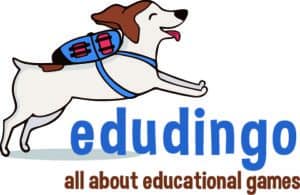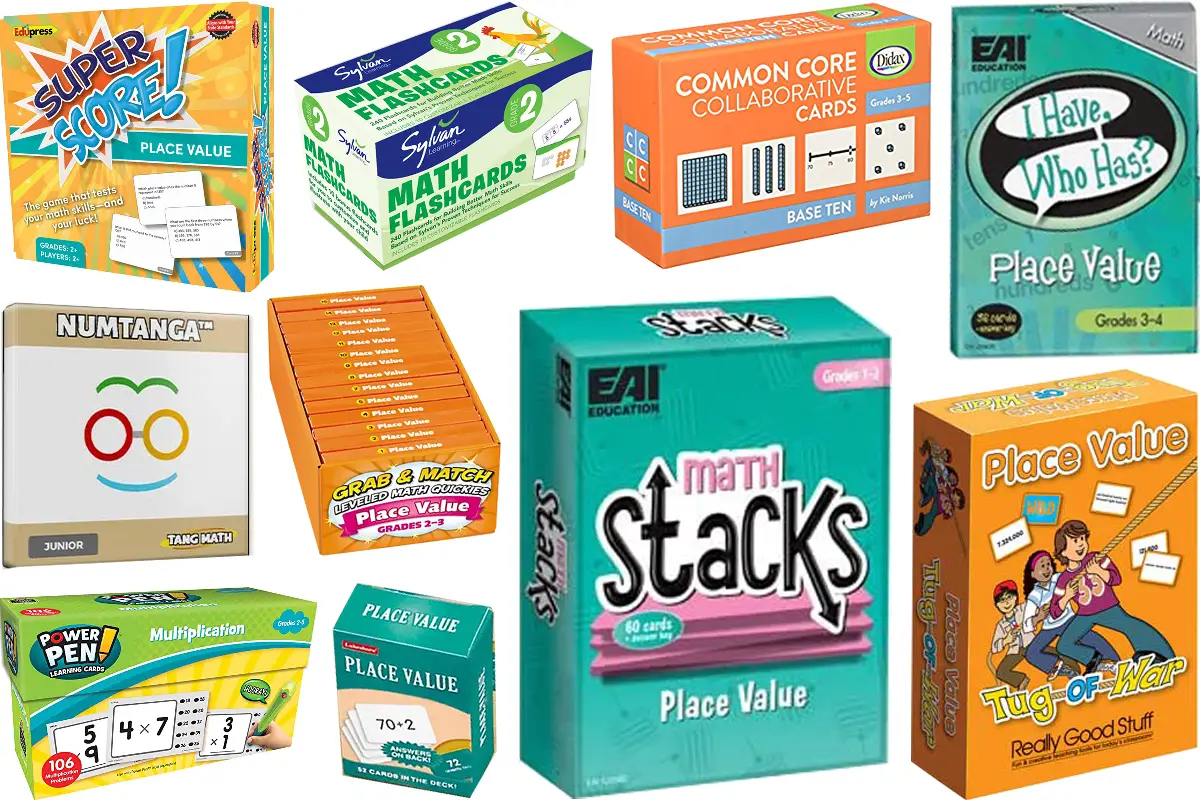This post contains affiliate links.
It is surprising to adults how hard it is for children to understand base 10 and place value – luckily here are 11 card games to make this more enjoyable.
This list is divided into three categories:
- Card Games, for example, Tug of War which teaches place values up to hundreds of thousands
- Flashcards, for example, Place Value Playing Cards which uses base 10 block representations to illustrate numbers
- Quiz cards, for example, Super Score Value
Place Value Card Games Comparison Table
| Game | Type | Age | Players | For | Price | Rating |
|---|---|---|---|---|---|---|
| Tug of War Place Value | Card | 7-8 | 2-4 | Families, Schools | $$ | ★★★☆☆ |
| I Have, Who Has? Place Value | Card | 7-9 | 4-12 | Schools | $$ | ★★★★☆ |
| I Have, Who Has (Learning Advantage) | Card | 6-7 | 4-12 | Schools | $$ | ★★★★☆ |
| Collaborative Cards-Base Ten | Card | 8‑10 | 16‑40 | Schools | $$ | ★★★★★ |
| Grab & Match Place Value | Card | 7-8 | 2-4 | Schools | $$$ | ★★★★☆ |
| Math Stacks Place Value Game | Card | 6-7 | 2-4 | Families, Schools | $$ | ★★★☆☆ |
| NumTanga Junior | Card | 5-7 | 2 | Families | $$ | ★★★☆☆ |
| Place Value Playing Cards | Card | 7-8 | 2-4 | Schools | $$$ | ★★★☆☆ |
| Sylvan Math Flashcards | Flashcard | 7-8 | 2-8 | Families | $$ | ★★☆☆☆ |
| Place Value Power Pen | Quiz Card | 7-8 | 2-4 | Families, Schools | $$ | ★★★☆☆ |
| Super Score Place Value | Quiz Card | 7-9 | 2-4 | Families, Schools | $$ | ★★★☆☆ |
Place Value Card Games
These card games focus on teaching place value concepts using base-ten representation, in word and numerical form.
Tug of War Place Value (Really Good Stuff)
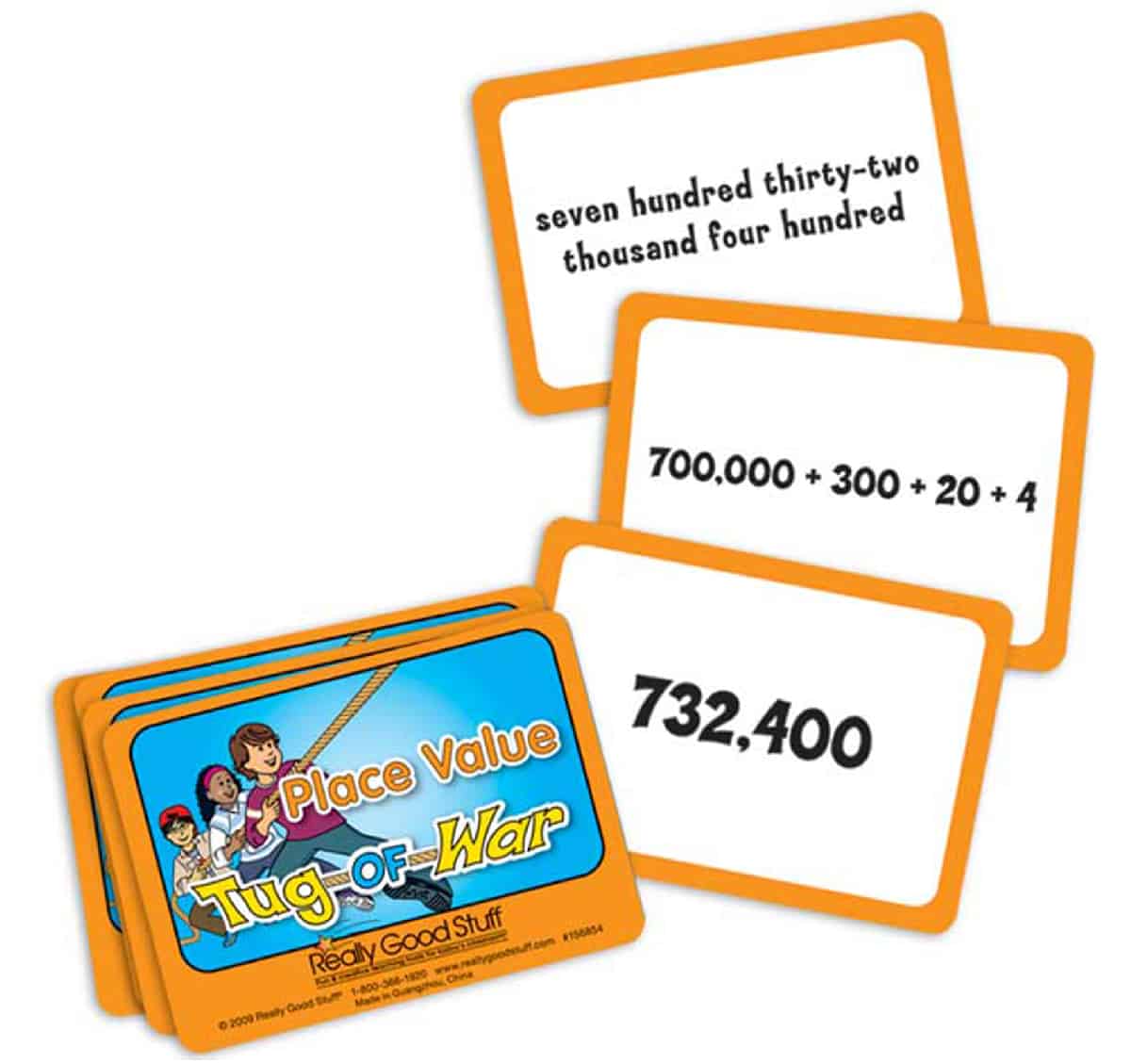
★★★☆☆
For Schools and Families | Age 7-8 | 2-4 Players
Tug of War Place Value is a game of War with 64 cards that represent whole numbers in three different forms:
is a game of War with 64 cards that represent whole numbers in three different forms:
- Digit form (732,400)
- Word form (seven hundred thousand thirty-two thousand four hundred)
- Expanded form (700,000 + 30,000 + 2000 + 400)
Children learn place values by reading and comparing numbers. There is no autocorrection mechanism to check for mistakes, but I recommend “Tug of War” though because it helps learn place value up to six digits (hundreds of thousands), which is not the case for most other games.
I Have, Who Has? Place Value (EAI Education)
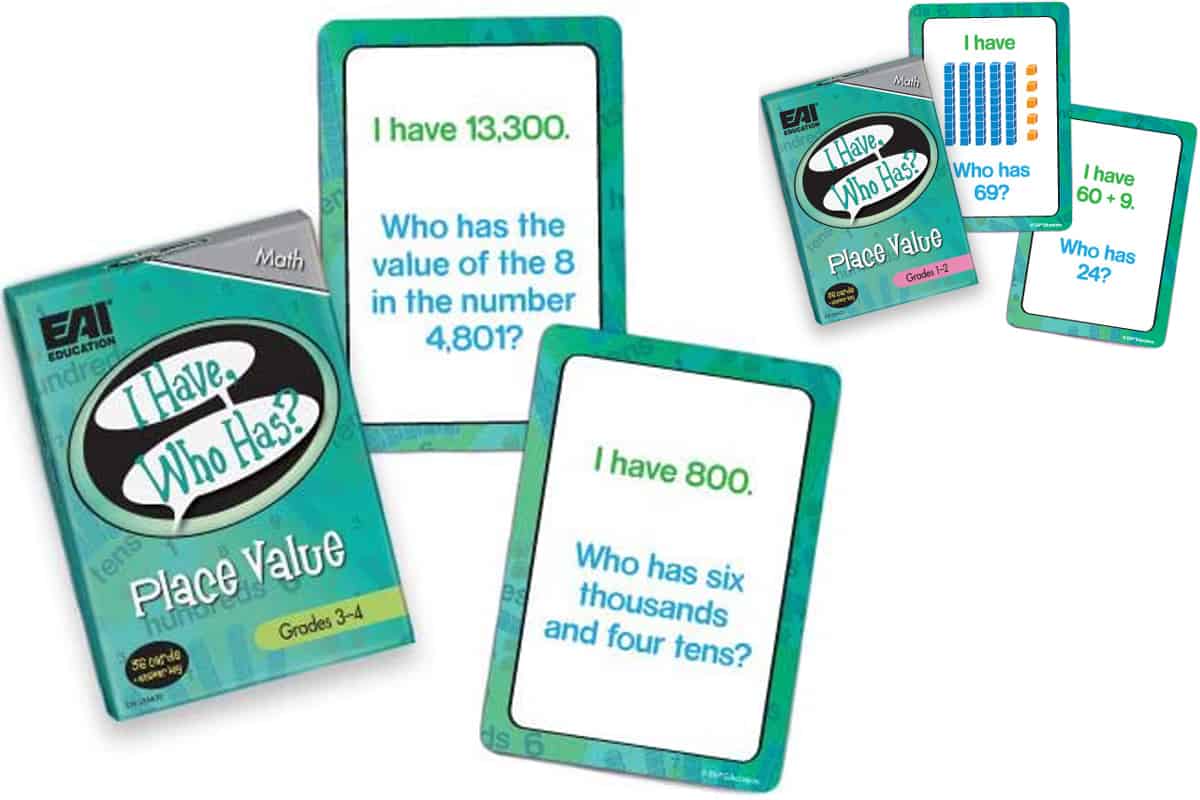
★★★★☆
For Schools | Age 7-9 | 4 to 12 Players
I Have, Who Has? is a classic at school (you can have a large group playing the game, all players participate because they always have to check their remaining cards, and it is super simple to setup and play).
is a classic at school (you can have a large group playing the game, all players participate because they always have to check their remaining cards, and it is super simple to setup and play).
This one features 36 cards and an answer key. The questions focus on:
- Naming the place value within the number
(Who has the value of 8 in the number 7801?) - Understanding the expanded form of the number
(Who has four thousand and three tens?)
Numbers are up to 5 digits (ten thousands), which is great.
Note: If you do not already know “I Have, Who Has?”, here is a quick reminder: Each card contains an “I have” answer and a “Who has” question. The current player reads the “Who has” question and the other players search for the answer on their cards. The player who holds the correct answer must reply “I have” and becomes the next player. The game continues until all cards are played.
I Have, Who Has? (Learning Advantage)
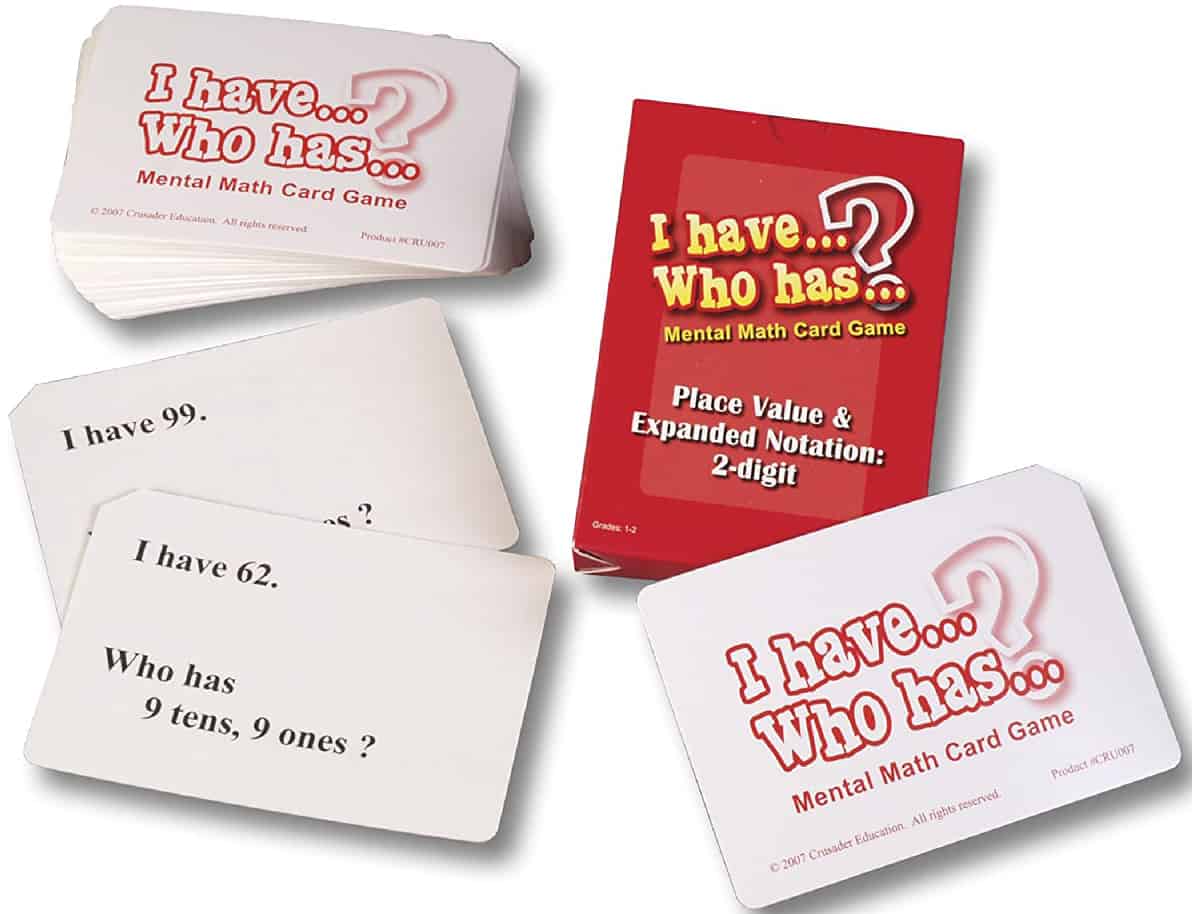
★★★★☆
For Schools | Age 6-7 | 4-12 Players
The version of I have, Who Has by Learning Advantage consists of 36 cards for teaching place values up to 3 digits.
by Learning Advantage consists of 36 cards for teaching place values up to 3 digits.
Compared with the “I Have, Who Has” from EAI Education, this one is tailored for younger children (6 to 7 year-olds) because it:
- Proposes Simpler questions (identification of the complete number, not specific digits)
- Includes (and uses) a base ten block representation, which is very useful for children who are beginning with place value
The “I have” portion of the card contains the base 10 block representation while the Who has portion contains the whole number in digit form.
Common Core Collaborative Cards- Base Ten (Didax)
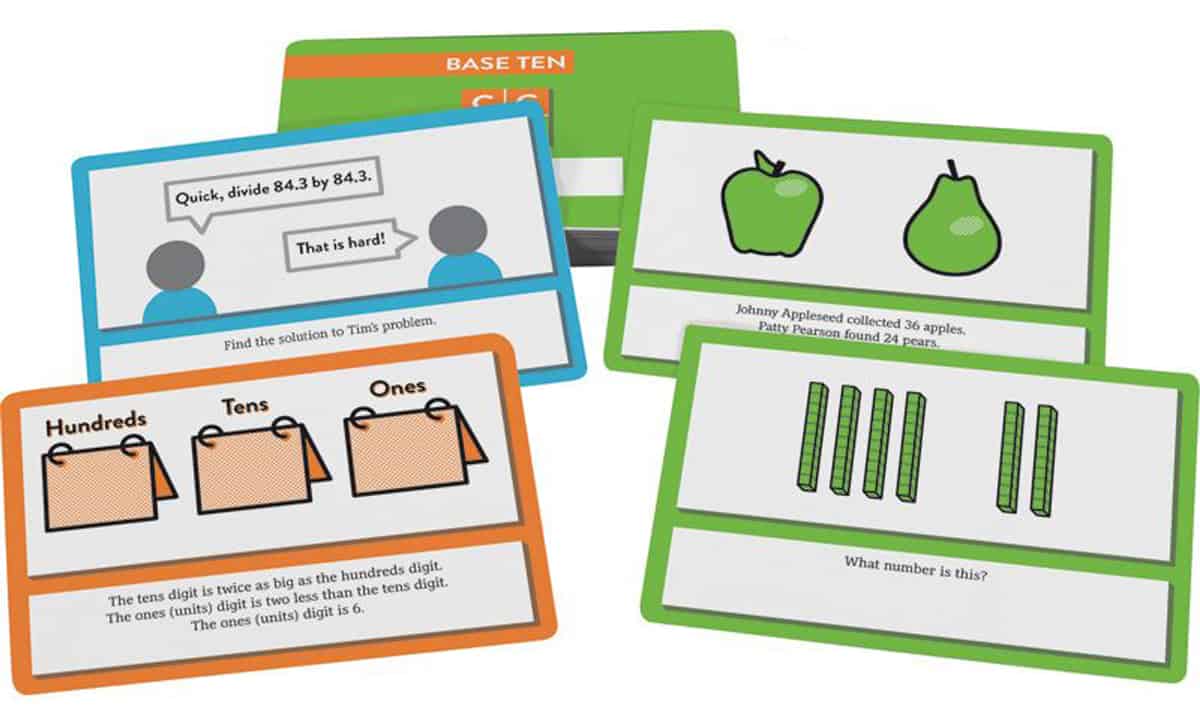
★★★★★
For School | Age 8-10 | 16-40 Players | Grade 3-5
Common Core Collaborative Cards-Base Ten is a set of 120 activity cards featuring place value word problems with pictorial representations, in 3 levels from Grade 3 to 5 (40 cards per level).
is a set of 120 activity cards featuring place value word problems with pictorial representations, in 3 levels from Grade 3 to 5 (40 cards per level).
In each level, the 40 cards are divided in 10 sets of 4 cards with the same answer, for example:
- What number is this? (Answer is based on base ten representation)
- Riddles/problems based on place values (some of them might be hard for 8-year-old children)
To play with the classroom, distribute a card per student. They have to find the other students who have a card with the same answer.
I give 4 stars because:
- The principle is very easy.
- The game spurs discussions to solve the problems and encourages cooperation
- You can have your whole class playing with just one game
- The progression is well thought out with the three levels for grades 3, 4 and 5
Grab & Match Place Value (Lakeshore Learning)
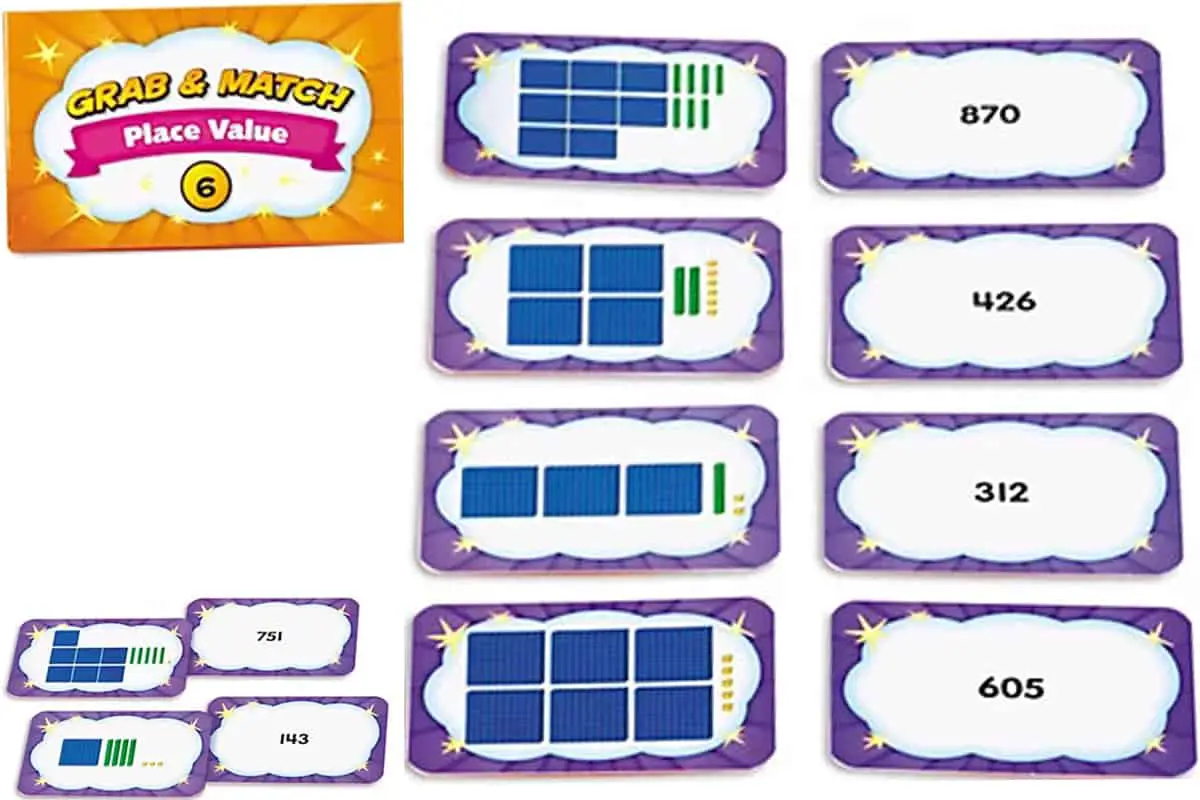
★★★★☆
For Schools | Age 7-8 | 2-4 Players| Grade 2-3
This comprehensive card set contains 15 place value card games pouches, each with 16 cards (240 cards overall), an activity guide, and an answer key.
contains 15 place value card games pouches, each with 16 cards (240 cards overall), an activity guide, and an answer key.
The pouches are of increased difficulty, to match the progression from grade 2 to Grade 3 (numbers up to 3 digits).
This gradual progress in difficulty is the strong point of the game. Almost all aspects of place value are handled: number block representation, expanded notation, number comparisons, operations in base ten, rounding…
Math Stacks Place Value (EAI Education)

★★★☆☆
For Families & Schools | Age 6-7 | 2-4 Players | Grade 1-2 | Duration: 15 mn
Math Stacks Place Value consists of 60 cards that represent 15 whole numbers up to 3 digits in four different forms:
consists of 60 cards that represent 15 whole numbers up to 3 digits in four different forms:
- Word form (Three hundred fifty-seven)
- Expanded form (3 hundreds, 5 tens, 7 ones)
- Digit form (357)
- Base 10 blocks
Players draw cards and stack them on other cards that represent the same number. The aim is to collect sets of four cards that represent the same number (the player with the most stacks in the end wins).
I recommend math stacks place value because
- The rule is very simple (even if not especially fun – there is essentially no interaction between players).
- You can play a game of War, which is more fun in fact than the original rule!
(it would even be possible to play a memory if the cards were not so large)
Numtanga Junior (Kakooma)
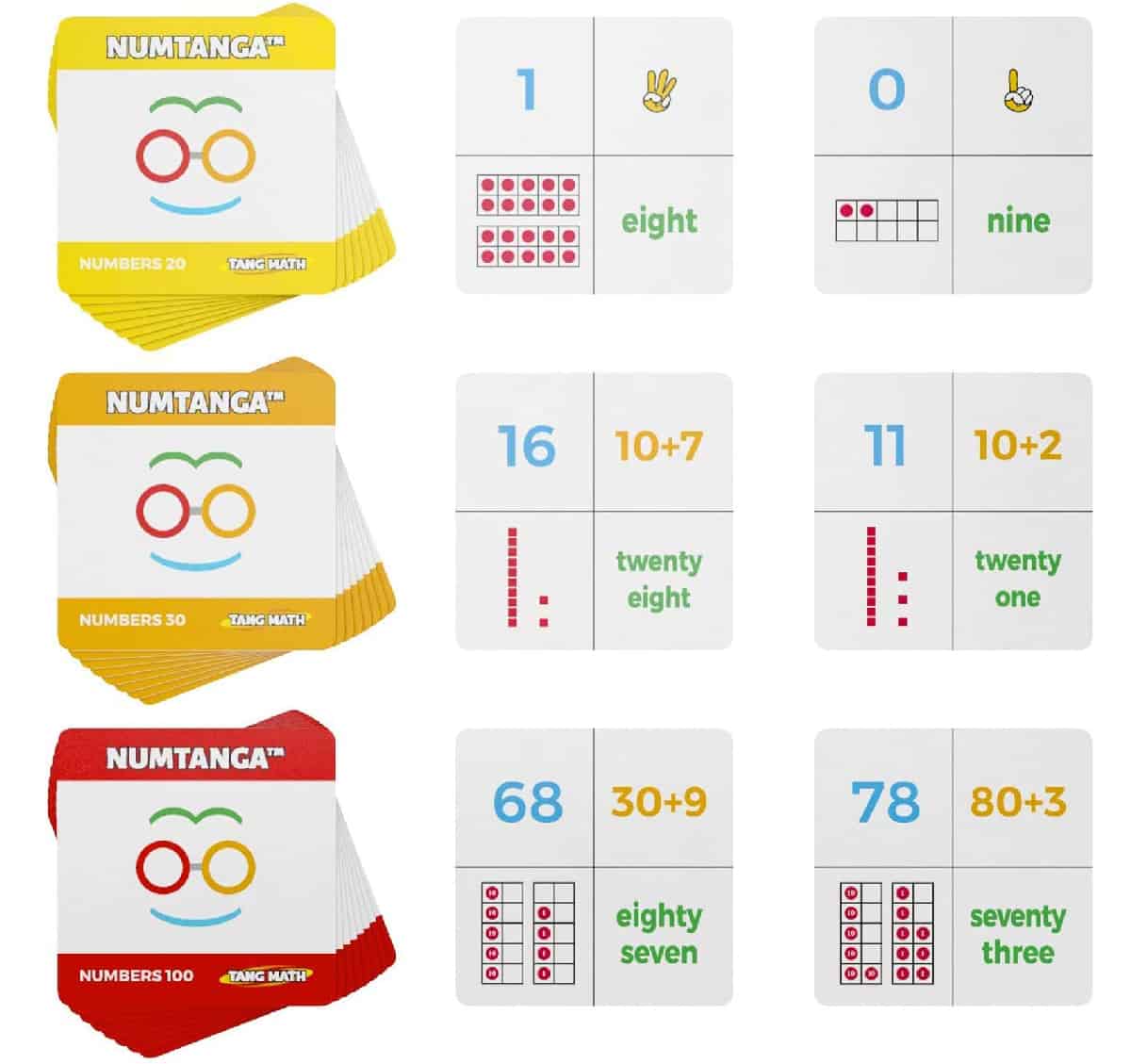
★★★☆☆
For Families | Age 5-7 | 2 Players | Grades K to 2
Numtanga Junior contains 3 decks of cards to learn small number representations and place value:
contains 3 decks of cards to learn small number representations and place value:
- One-digit numbers (good for Kindergarten)
- Two-digit numbers up to 30 (Grade 1)
- Two-digit numbers up to 99 (Grades 1 and 2)
Each card contains 4 boxes with different representations of whole numbers (here sorted from the easiest to the most difficult):
- Hands
- Base 10 blocks
- Digit form (17)
- Ten-frames
- Expanded form (10+7)
- Word form (seventeen)
To play the game, flip two cards and try to find the match between the cards (the first player who finds the match takes the cards).
The strong points:
- Very simple rule, easy to set the duration of the play
- Plastic cards (very durable)
- Manages progression
The less good:
- Very competitive game (not a good fit for school as the strongest student always win) – not a problem at home if you let the child win 😊, which is why I recommend only in a setting with an adult and a child.
- The game mechanism is a bit too basic for my taste (no interaction between players), but I understand that for most very young children it is fine (for 7-year-old children I would recommend games with more interesting rules)
Place Value Playing Cards (Lakeshore Learning)
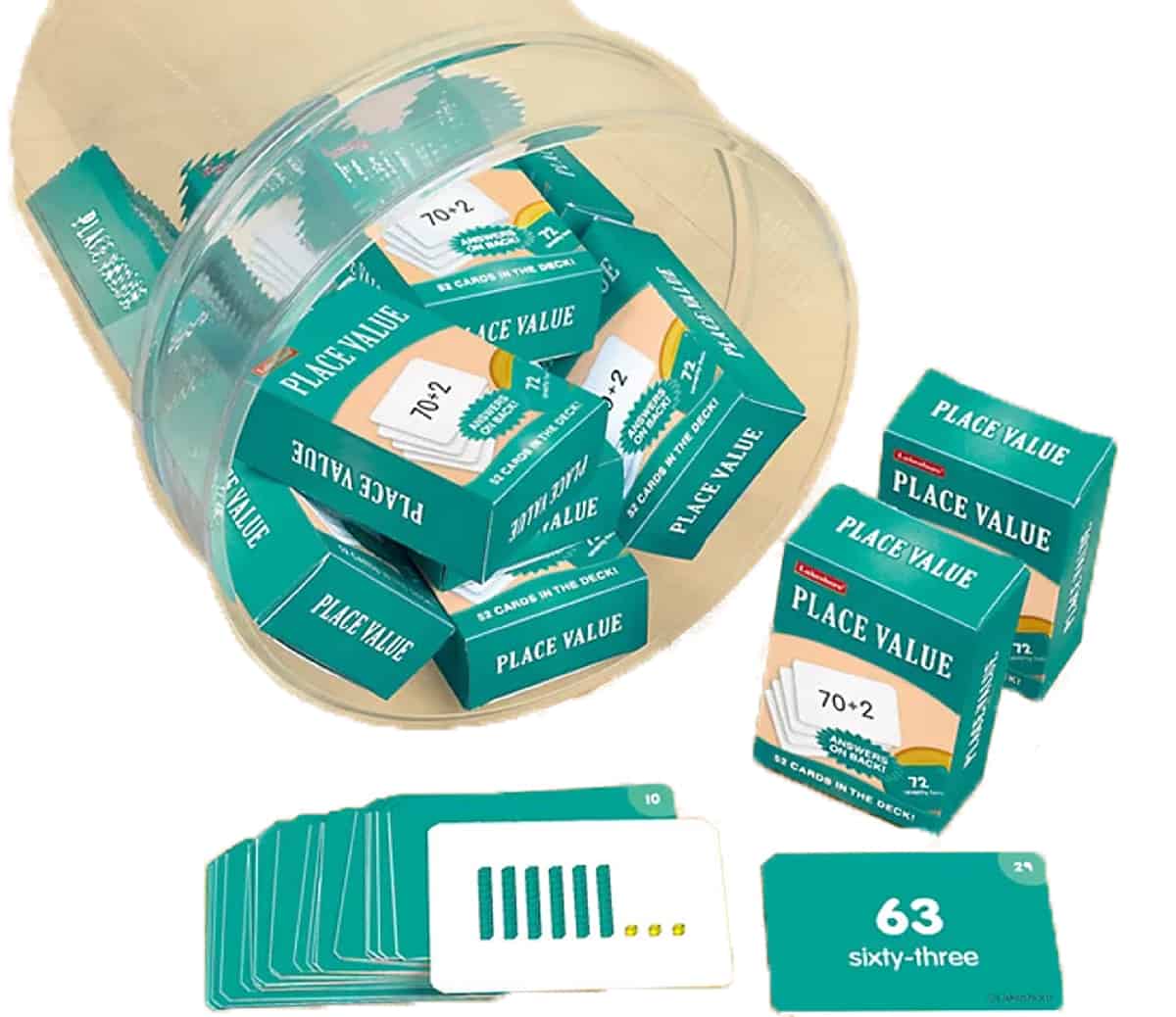
★★★☆☆
For Schools | Age 7-8 | 2-4 Players per deck – 18 decks
Place Value Playing Cards is a set of 18 identical 52 card decks that can be used to play several rules such as place value war or slapjack or be used as flashcards. Each card has the same number in:
is a set of 18 identical 52 card decks that can be used to play several rules such as place value war or slapjack or be used as flashcards. Each card has the same number in:
- Front side: Digit and word forms
- Backside:
- Color-coded base ten block representation
- OR expanded form (70+2)
I do not give a higher rating as selling only 18 deck sets makes the game nonsuitable for families, although the game could be played at home (a missed opportunity I believe), because the design could be less basic (but I understand this I for schools only), and also because the tub is not a good idea IMHO for storage (wastes space, decks can be more easily damaged, “low quality” feeling).
Place Value Flash Cards
Sylvan Math Flashcards (Sylvan Learning)
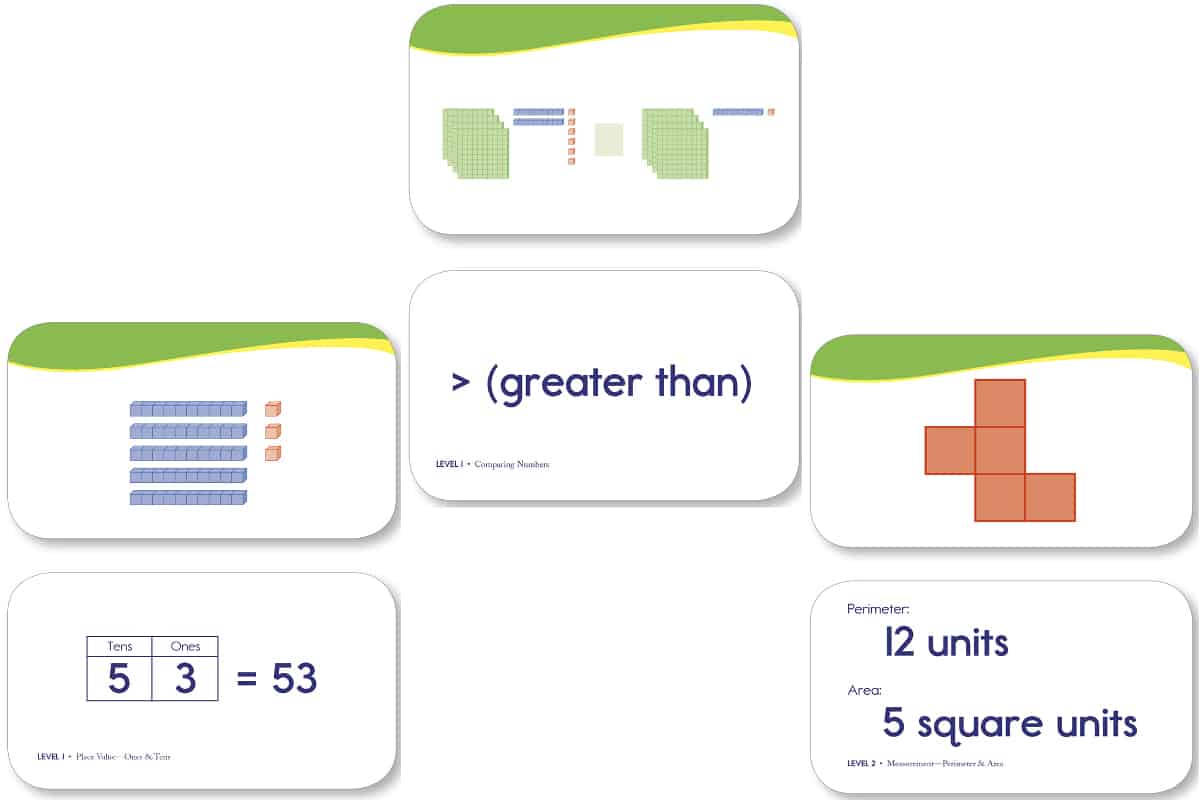
★★☆☆☆
For Families | Age 7-8 | 2-8 Players
The box contains 230 flashcards and 10 blank cards (can be used by children to draw their own examples). They cover several mathematics lessons for second-grade students, including place value.
(can be used by children to draw their own examples). They cover several mathematics lessons for second-grade students, including place value.
What I find helpful in using these flashcards is the illustration. The presentation is simple, clear and easy to remember.
The cards for place value contain:
- Numbers in place value chart and level of difficulty (front side)
- Base ten blocks (backside)
Overall, Sylvan Math Flashcards is an OK learning option to revise number-related notions at home with 7–8-year-old children, including place value.
is an OK learning option to revise number-related notions at home with 7–8-year-old children, including place value.
Place Value Quiz Cards
These quiz cards propose cards with multiple choice questions. The questions can be answered individually or by pair.
Place Value Power Pen (Lakeshore Learning)
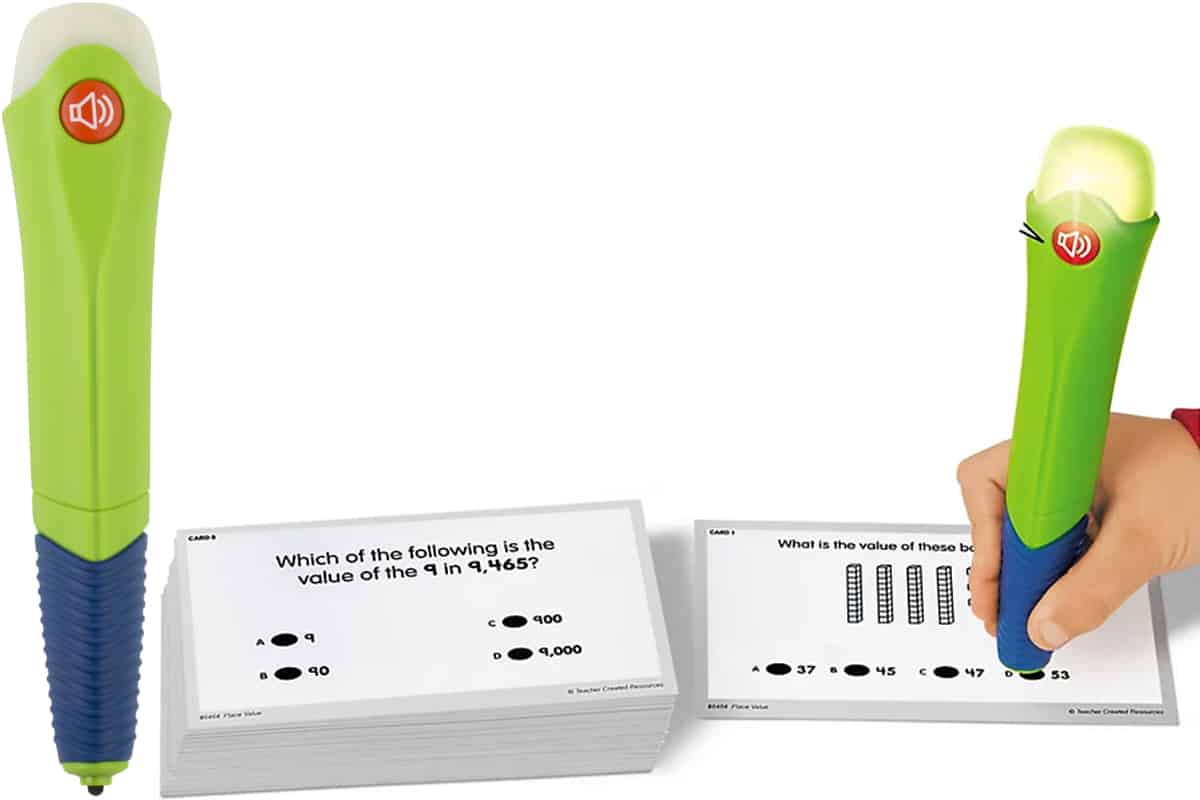
★★★☆☆
For Families, Schools | Age: 7-9 | 2-4 Players
Place Value Power Pen is a quiz set that uses a talking pen to check the answers to multiple-choice place value questions.
is a quiz set that uses a talking pen to check the answers to multiple-choice place value questions.
The set includes
- 53 double-sided cards (106 questions)
- An answer key (you can use it when you do not have the pen)
- An optional optical AA battery-operated pen: you point it to the chosen answer and it tells you (by voice and with a green light) if the answer is correct (sold separately)
I like the fact that the questions are varied. It requires players to
- Identify the place value in the number (What is the value of 9 in 9786?)
- Identify the place value from illustrated base 10 blocks
- Compare numbers
The pen enables to play the game alone, while the cards allow to get the questions in random order and to sort out the questions that are too easy for the child.
Having immediate feedback is essential for learning, making the pen-based verification very useful.
The downside is that the cards are not pretty (black and white, basic design, should I say a bit ugly?). There is no attempt at making anything fun, which makes it more suitable for school than home. Why not make a little effort and design more appealing cards? I do not like very much the format of the cards either. They are very wide, and there is no compelling reason for that.
Super Score Place Value (Edupress)
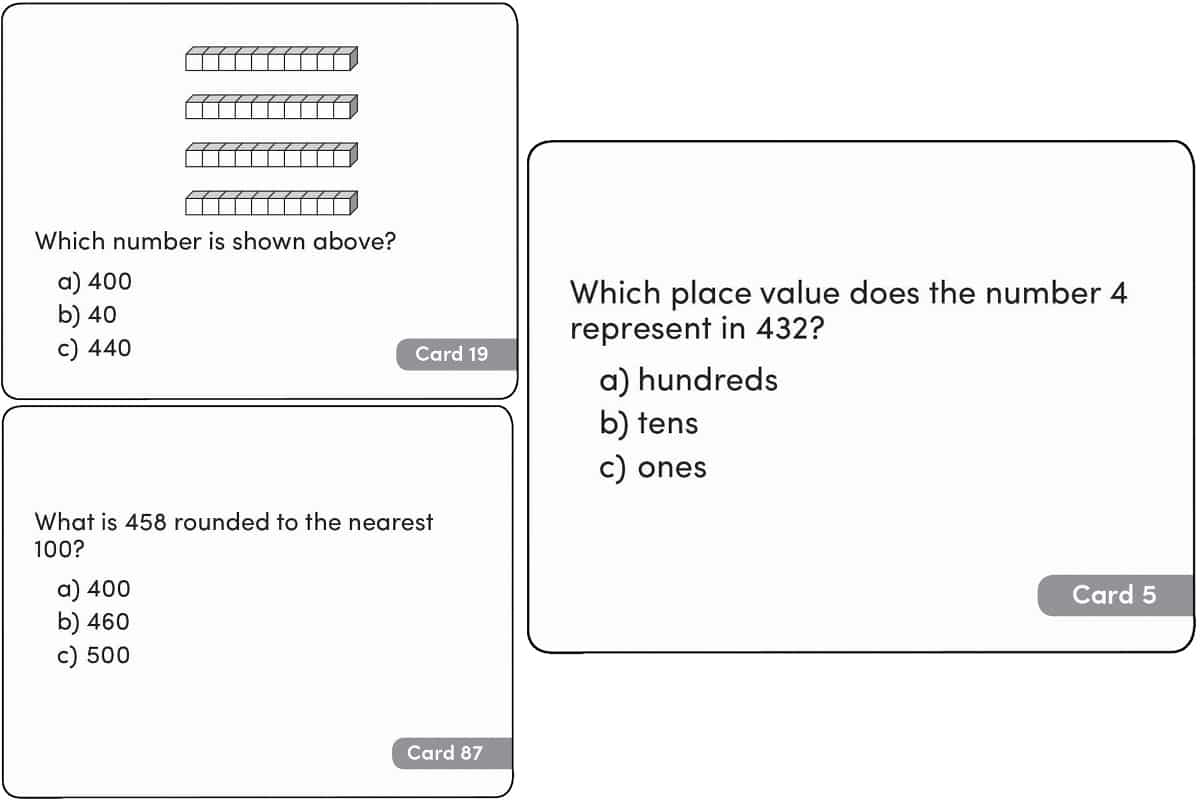
★★★☆☆
For Teachers and Families | Age 7-9 | 2-4 Players
In Super Score – Place Value , players solve place value problems to collect points. Aside from reinforcing the player’s understanding of place value, this game also makes players work additions, subtractions, as well as rounding.
, players solve place value problems to collect points. Aside from reinforcing the player’s understanding of place value, this game also makes players work additions, subtractions, as well as rounding.
Students take turns drawing cards and solving the place value problems presented on them to collect points. If lucky, you may even draw a Score Card. The game ends once a player has collected four Score Cards. The player with the highest score wins.
Cards are formatted so that students pick their answer from one of three potential solutions, for example:
What is 641 rounded to the nearest 100?
- 600
- 640
- 700
The game mechanics are not fun, but the questions are relevant and do introduce rounding, additions, and subtractions which is an important part of understanding how place value works.
Why is Place Value Confusing?
Studying place value is a long process.
Young children need concrete examples to connect spoken numbers (numbers they use when they count) to written numbers (in digit form and word form) and values (quantities).
Introducing the value of the digit when it changes its position within the number confuses children, even more, when they have trouble distinguishing left from right.
The following illustrations are helpful in providing concrete examples for place values:
- Place value charts (a diagram that helps children find and compare place value where the place value increases ten times as we move to the left of the place value chart)
- Place value grids (similar to place value chart but its size and complexity increases as children progress from Grade 1 to Grade 6)
- Objects (also called manipulatives which include building bases, units, rods, flats, and cubes)
- Pictorial representations (include base 10 blocks, ten frames, flip chart)
When children understand the place value concepts clearly, it will be easier for them to understand other important math concepts.
Other Types of Place Value Games
If you are interested in more place value games, you might want to check my post “12 Place Value Board Games for Schools and Families ”.
”.
If you are interested in place value games that have manipulatives, I recommend that you check out my post about place value activity sets.
Edudingo.com is a participant in the Amazon Services LLC Associates Program, an affiliate advertising program designed to provide a means for sites to earn advertising fees by advertising and linking to Amazon.com. We also participate in other affiliate programs which compensate us for referring traffic.
